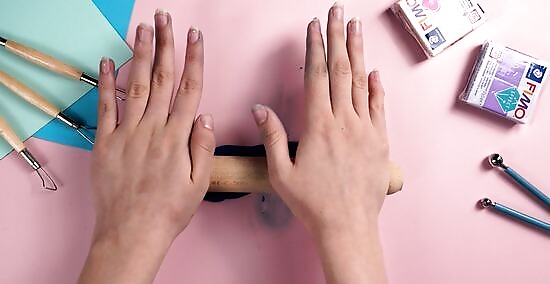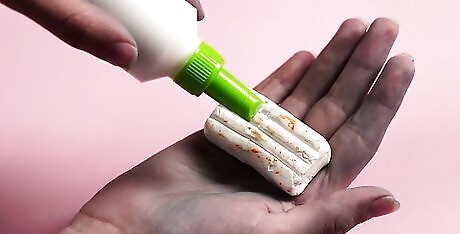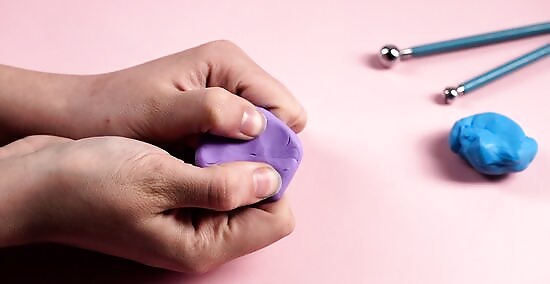
views
Warming and Kneading the Clay
Warm the clay with body heat. If your clay is only slightly hard, you may be able to soften it just by warming and kneading it with your hands. Before you start kneading the clay, hold the clay in your hands to warm it. You can also warm it using the heat of your body by sitting on top of it. Warmth helps to revitalize the clay. If your clay is only a little bit hard, you may be able to restore its softness just using body heat. No matter what method you use to soften clay, always warm it first.

Warm the clay using a heat source. If the clay is especially hard, you may need to use a heat source to soften the clay. Lay a hot water bottle over your clay for twenty minutes to help soften it. You can also use a heat lamp, but be sure to not heat the clay over body temperature. This can cause the clay to start to bake, which will make it unusable. Additionally, you can put the clay in the microwave for 10-second spurts until it is warm.

Roll the clay in your hands. Once the clay has softened, roll it between your hands in a snake shape, then roll it into a ball. Rolling the clay creates friction, which helps to soften it. You can also cut the clay into small pieces, then roll it.

Roll with a rolling pin. If the clay is still too hard to roll with your hands, you may need to use more force. Lay the piece of clay on a clean cutting board or on the counter, then press down on the clay to flatten it out as much as you can. Then roll the clay out with a rolling pin. After you roll it out, it should be warm enough to roll with your hands.

Hit the clay with a mallet. If your clay is too hard to roll out with a rolling pin, you will need a large amount of force. Break the clay up into as small of pieces as you can, then place the clay pieces in a sealed plastic bag. Wrap the bag with a cloth and put it on the floor or on the cement or pavement outside. Use a rubber mallet to pound on the clay for several minutes. Using the mallet will break up the clay and add friction which will make it softer. After you have used the rubber mallet, take the clay out of the bag and roll it with your hands into a ball.
Knead the clay. After you have rolled the clay, knead the clay with your hands on a counter just as you would with dough. Use as much force as you need to pull apart and reshape the clay. Kneading the clay ensures that you handle the entire surface area of the clay. You can also use a clay-kneading machine if you don’t want to knead by hand. EXPERT TIP Sarah Stearns Sarah Stearns DIY Specialist Sarah Stearns is a DIY Specialist, Artist, Maker, Blogger, and the Founder of SarahMaker.com. With over ten years of experience, she specializes in fun, approachable crafts like crocheting, making polymer clay jewelry, quilting, and creating Cricut projects. Her work has been featured in several publications, such as Scientific American, Good Housekeeping, Vox, and Apartment Therapy. Sarah holds a BA in Psychology from Vanderbilt University. Sarah Stearns Sarah Stearns DIY Specialist Knead dried polymer clay to softe itn. If polymer clay becomes dry and difficult to work with, start by firmly kneading the clay in your warm hands. You can also chop it into smaller pieces or run it through a pasta machine to warm and condition it. After trying these methods the clay will hopefully become smooth and pliable again.
Adding Softening Agents to the Clay

Add in a liquid diluent. A liquid diluent is one product on the market that softens unworkable clay. Many diluents are manufactured by the companies that make polymer clay, and they are made specifically for rejuvenating old clay. Use liquid diluents if warming and kneading the clay doesn’t work to soften it. Add in liquid diluents a drop at a time as you knead the clay. Adding too much can make the clay mushy. Liquid diluents can be used as a glue, and therefore may add stickiness to your clay. If your clay is becoming too sticky, wrap it in a paper towel to absorb some of the stickiness.

Use a bar of clay softener. There are also several clay softeners that come in bar form. Instead of being liquids that you add, the bars are made of a neutral mixing compound that helps your clay become more workable. Use one part of solid clay softener to five parts of clay. Warm the clay, then add the bar clay softener and knead until the clay and the clay softener are mixed. Bar clay softeners are whitish colored and therefore work best with highly saturated clay. Be aware that adding too high a ratio of bar clay softener can dilute the color of the clay.

Add in liquid clay. Liquid polymer clay is another material that can be used to make hard clay more pliable. Use liquid polymer in a similar way as you would the diluent, adding it drop by drop and kneading the clay in between drops until the clay has reached the right consistency. Try to use uncolored liquid clay so that it doesn’t affect the color of the clay. You can also use tinted liquid clay, but it will slightly change the original color.

Add mineral oil. Even though mineral oil is not made specifically for helping to soften clay, it does work wonders to soften and improve the texture of polymer clay. Add in a drop of mineral oil at a time, kneading in between each drop until the clay is workable.

Rub the clay with petroleum jelly. Petroleum jelly is a common household product that you can use if you don’t have access to commercial clay softeners. To use petroleum jelly, dab a small amount on your fingers and rub it into the clay. Then knead the clay to mix in the petroleum jelly. Keep adding more until you reach the optimal consistency.

Combine hard clay with fresh clay. Another option that you have is to simply tack on fresh clay to the hardened clay, then knead the clays together. The more new clay that you add, the softer the combined clay becomes. Be sure to add clay of the same color unless you don’t mind the colors mixing. Knead the clay with your hands until the clay feels consistent throughout.
Chopping the Clay
Chop the clay with a knife. If you are working with very hard clay, you may need to use a food processor to really break down the clay and warm it up. Before you put the clay pieces into the food processor, first use a sharp knife or cleaver to chop the clay into the smallest pieces that you can.
Place the clay and a softening agent in a food processor. Once you have chopped the clay as much as you can, take the chopped pieces and put them in a food processor. If you wish, add a few drops of diluent or liquid polymer clay to the food processor as well to further help soften the clay. Then place the lid on the food processor. You can also use a coffee grinder, but you may have to grind in several batches. A pasta machine also works for this. Try to get a separate bowl and blade for mixing clay because unless you clean them extremely thoroughly it is not advisable to use the same ones for food and clay.

Grind in ten-second spurts. Use the highest setting on your food processor to grind the clay. Grinding the clay will separate it into smaller pieces and soften it, making the clay easier to work with. Grind for one to three minutes, until the clay is soft.

Remove the clay and combine the pieces. After the clay is soft, take it out of the food processor. You may need to use a spoon to scrape the sides and get the clay out of the nooks and crannies of the food processor. Once you get all the clay out, press the pieces together to combine them.

Knead the clay in your hands. After you have chopped the clay in the food processor, it should be soft and pliable. Knead the clay in your hands to completely blend the pieces together. It should now be soft and ready for use!


















Comments
0 comment